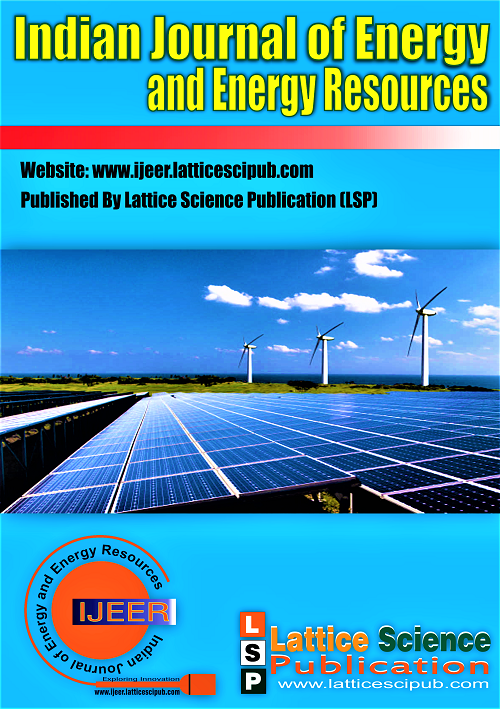In-situ and Ex-situ Conversion of Coal to Methane using Hydrogen
Main Article Content
Abstract
This paper explains a process to produce methane using coal, steam, and hydrogen by autothermal reactions. In coal gasification, oxygen is used to burn extra coal for providing the necessary energy to the process. The proposed process uses hydrogen in place of oxygen to provide the necessary energy to produce methane. The process uses fossil coal as a feedstock only and not as a fuel. Both ex-situ and in-situ methods are feasible to produce methane/natural gas from coal and green hydrogen. For one unit mass of hydrogen, nearly 24 times methane production is feasible. The required carbon-neutral hydrogen can be generated adequately and economically from water electrolysis by using green renewable electricity from solar PV and wind power potential. The carbon footprint of methane production using coal and green hydrogen is nearly 83% more than that of fossil natural gas but 23% less compared to fossil coal on an equivalent energy basis. The abundant inferior quality coal deposits in India can be used as carbon feedstock to produce methane gas for the fuel requirements of domestic, commercial, and road transport sectors. The existing natural gas infrastructure like cross country pipelines, PNG infrastructure, CNG filling stations, LNG storage facilities, etc remain in use and are further expanded to use the methane produced from coal deposits. The green carbon dioxide gas available from biomass gasification can be sequestered into underground caverns and depleted natural gas or crude oil deposits to brand the grey methane, produced from fossil coal, as carbon neutral fuel. Thus, India can transform into a carbon-neutral economy with robust energy security/independence from a predominantly fossil fuels importing country to an exporter of green fuels, chemicals, and products by harnessing its vast coal, biomass, and renewable energy resources.
Downloads
Article Details

This work is licensed under a Creative Commons Attribution-NonCommercial-NoDerivatives 4.0 International License.
How to Cite
References
Statistical Review of World Energy, (2024). Energy Institute. https://www.energyinst.org/statistical-review
JD Blackwood. (1959). The reaction of Carbon with Hydrogen at High Pressure, Australian Journal of Chemistry 12(1) 14 – 28. https://www.publish.csiro.au/CH/CH9590014
Jean-Michel Lavoie. (2014). Review on dry reforming of methane, a potentially more environmentally-friendly approach to the increasing natural gas exploitation, Front. Chem. https://www.frontiersin.org/journals/chemistry/articles/10.3389/fchem.2014.00081/full
Michael Ioelovich. (2025). How to control reactions of syngas, World Journal of Advanced Research and Reviews, 2025, 25(02), 296-304. DOI: https://doi.org/10.30574/wjarr.2025.25.2.0337
Michael Ioelovich. (2024). Thermodynamic analysis of methane synthesis by hydrogenation of carbon dioxide, World Journal of Advanced Research and Reviews. 2024, 24(02), 927–931 https://wjarr.com/sites/default/files/WJARR-2024-3421.pdf
Weiwei Li et al. (2021). Catalytic coal gasification for methane production: A review, Carbon Resources Conversion, Vol 4. https://www.researchgate.net/publication/262880111_Reaction_characteristics_through_catalytic_steam_gasification_with_ultra_clean_coal_char_and_coal
P. L. Walker et al. (1959). Gas Reactions of Carbon, The Pennsylvania State University. https://personal.ems.psu.edu/~radovic/PLW/1959_11_133_Walker_AdvCatal.pdf
Leila Dehimi et al. (2025). Hydrogen production by the water-gas shift reaction: A comprehensive review on catalysts, kinetics, and reaction mechanism, Fuel Processing Technology, Vol 267. DOI: https://doi.org/10.1016/j.fuproc.2024.108163
Nallapaneni Sasidhar. (2023). Carbon Neutral Fuels and Chemicals from Standalone Biomass Refineries, Indian Journal of Environment Engineering, November 2023. https://www.ijee.latticescipub.com/wp-content/uploads/papers/v3i2/B1845113223.pdf
Gemco Energy. (2024). Comparison Between Updraft and Downdraft Gasifiers. https://gasificationplant.com/biomass-energy/comparison-between-updraft-and-downdraft-gasifiers/
Kinetics vs. Thermodynamics, Utah education. https://my.eng.utah.edu/~lzang/images/lecture-1.pdf
Indian Oil Corporation Ltd. (2022). Purchase price of Compressed Biogas under SATAT scheme. https://satat.co.in/satat/assets/download/CBG%20Pricing%20Circular%20-%20Stakeholders.pdf
LNG Industry magazine. (2024). Small scale LNG to the rescue, 25 Apr 2024. https://www.lngindustry.com/special-reports/25042024/small-scale-lng-to-the-rescue/#:~:text=Small%20scale%20LNG%20technologies%20encompass,cycles%20and%20vapour%20compression%20cycles
Paulo Liu at el. (2023). Competitive Pricing of Hydrogen as an Economic Alternative to Gasoline and Diesel for the Houston Transportation Sector. UH energy white paper series: No. 05. 2023 https://uh.edu/uh-energy-innovation/uh-energy/energy-research/white-papers/white-paper-files/uh_energy_white_paper_hydrogen_fuel_oct23b.pdf
Gaurav Tripathi, Atul Dhar. (2022). Performance, emissions, and combustion characteristics of methane-diesel dual-fuel engines: A review, Front. Therm. Eng., 12 September 2022. https://www.frontiersin.org/journals/thermal-engineering/articles/10.3389/fther.2022.870077/full
Bajaj Allianz. (2024). BS-6 emission norms. https://www.bajajallianz.com/blog/motor-insurance-articles/the-difference-between-bs4-and-bs6-emission-norms.html#:~:text=The%20main%20pollutants%20controlled%20by,limits%20set%20by%20BS4%20norms.
Understanding Global Warming Potentials, Environmental Protection Agency, United States. https://www.epa.gov/ghgemissions/understanding-global-warming-potentials#:~:text=Methane%20(CH4)%20is%20estimated,hundreds%20or%20thousands%20of%20years.
AQI. (2024). Not just Delhi: the situation of air pollution in North India is worsening! 14 November 2024. https://www.aqi.in/blog/the-situation-of-air-pollution-in-north-india-is-worsening/#:~:text=Highly%20populated%20cities%20have%20more,pollution%20traps%20in%20these%20cities.
Davide Clematis et al. (2023). Hydrogen Carriers: Scientific Limits and Challenges for the Supply Chain, and Key Factors for Techno-Economic Analysis, Energies journal. DOI: https://doi.org/10.3390/en16166035
Yang Liu et al. (2017). Techno-economic and environmental analysis of coal-based synthetic natural gas process in China, Journal of Cleaner Production, Volume 166, 10 November 2017, DOI: https://doi.org/10.1016/j.jclepro.2017.08.011
Government of India. (2021). National Coal Gasification Mission, Ministry of Coal. https://coal.gov.in/sites/default/files/ncgm/ncgm21-09-21.pdf
N. Sasidhar. (2020). Future of Biomass Economy in Carbon neutral India, SCRIBD. https://www.scribd.com/document/487672079/Future-of-Biomass-economy-in-carbon-neutral-India
Nallapaneni Sasidhar. (2023). Multipurpose Freshwater Coastal Reservoirs and Their Role in Mitigating Climate Change, Indian Journal of Environment Engineering. https://www.ijee.latticescipub.com/wp-content/uploads/papers/v3i1/A1842053123.pdf
Karthik, Mr. J. P., Sasanka, Dr. C. T., & Raghuraman, Dr. C. M. (2020). Influence of Parameters in Coal Water Slurry Mixing used for Gasification in Power Plant. In International Journal of Recent Technology and Engineering (IJRTE) (Vol. 9, Issue 1, pp. 1321–1329). DOI: https://doi.org/10.35940/ijrte.a1722.059120





